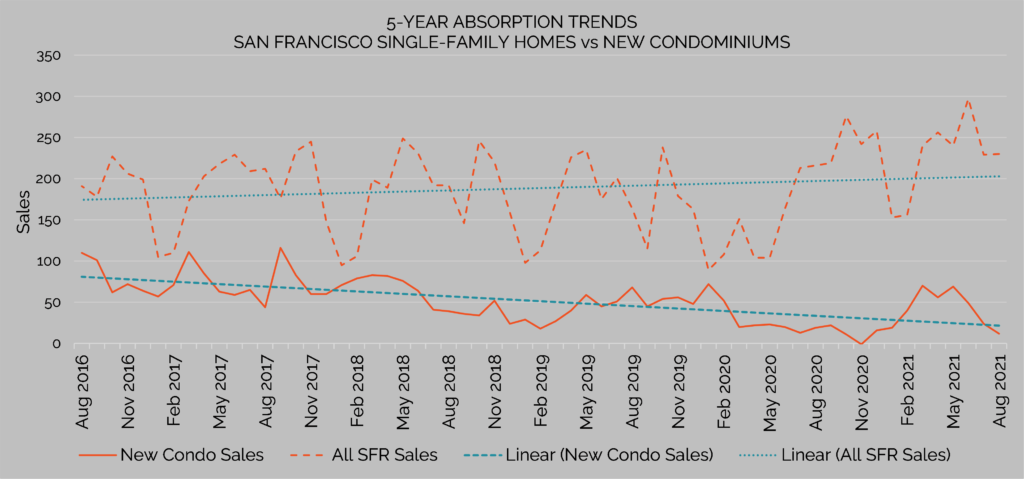With the Pacific Ocean to the West, The Bay to the North and East, and Silicon Valley to the South. San Francisco is a seven-by-seven-mile square of land optimized to produce extremely high home prices. And it has. The median price per square foot for single-family homes is more than $1,000. New condominiums, meanwhile, have climbed to more than $1,400 per square foot. Despite high prices, demand for single-family homes has soared during the pandemic.
In a city where detached housing is a rare luxury, sales of single-family homes have far outpaced sales of new condominiums. Demand is so strong that the average premium above list price paid by single-family home buyers in September was 16.9%. The imbalance between buyers and sellers is extreme: there are currently 329 active single-family home listings, compared to 235 sales last month. This equates to an active inventory of only 1.4 months of supply. Buyers are snapping up new single-family home listings so fast that the average number of days on market for September sales was 12.
New condominiums, on the other hand, are comparatively easy to purchase. First and foremost, there are far more of them. There are currently between 900 and 1,000 new condominiums offered for sale – approximately three times the inventory of single-family homes. Second, new condominiums do not typically allow multiple bids. Developers are free to negotiate with buyers, but that means that a purchaser could pay less than list price – not more. Lastly, new condominiums are usually sold by teams of agents, often working from elaborate sales centers designed to show off all aspects of the development.
Despite all these factors, there have been seven times as many single-family home sales over the past year than new condominium sales. In August, the difference was even more extreme: there were 230 single-family home sales compared to 12 new condominium sales. Why are buyers choosing single-family homes over new condominiums? The pandemic is certainly a factor, but as shown above, this trend started before the pandemic, and has only accelerated since 2020.
Here is a list of factors that may be contributing to buyers’ recent preference for single family homes.
Pandemic Factors
- Flight from density
- Avoidance of vertical living and
risk of catching covid in a
common area such as an elevator - Need for more space to work
from home - Mandatory home school
- Higher wage jobs (more likely to
qualify for a single-family home) were not as impacted by the pandemic - Dense condominium neighborhoods – such as SOMA – are ghost towns with most office employees working from home
Pre-Pandemic Factors
- Dense condominium neighborhoods – such as SOMA – have become home to a growing number of homeless San Franciscans
- Most new condominiums are large high-rises targeting ultra-luxury buyers, which represent a relatively small segment of the buyer pool
How can developers help tilt the balance back toward new condominiums? Other than ending the pandemic, here are several concepts worth exploring:
- Design smaller homes. By offering more compact homes, the overall purchase price will lower,
thus appealing to buyers priced out of most new condominium developments. - Look for infill opportunities outside of the urban core. While demand will undoubtedly return to SOMA once the pandemic subsides, not all condominium buyers want to live in the center of the action. As The City grows, smaller, neighborhood-scale developments will appeal to other buyers who may not have considered buying a condominium.
- Build for tomorrow’s buyer. Condominium developments – especially in The City – take years to plan and build. As a result, needs that seem obvious now were often neglected during the planning process years ago. Most new developments do not offer electric car charging in all parking spaces. Solar power is not universally included. Package storage is a constant headache in many relatively new buildings. Think about what is next and keep your eye on current trends.
All information is from sources deemed reliable but no guarantee is made as to its accuracy. All material presented herein is intended for informational purposes only and is subject to human errors, omissions, changes or withdrawals without notice.








